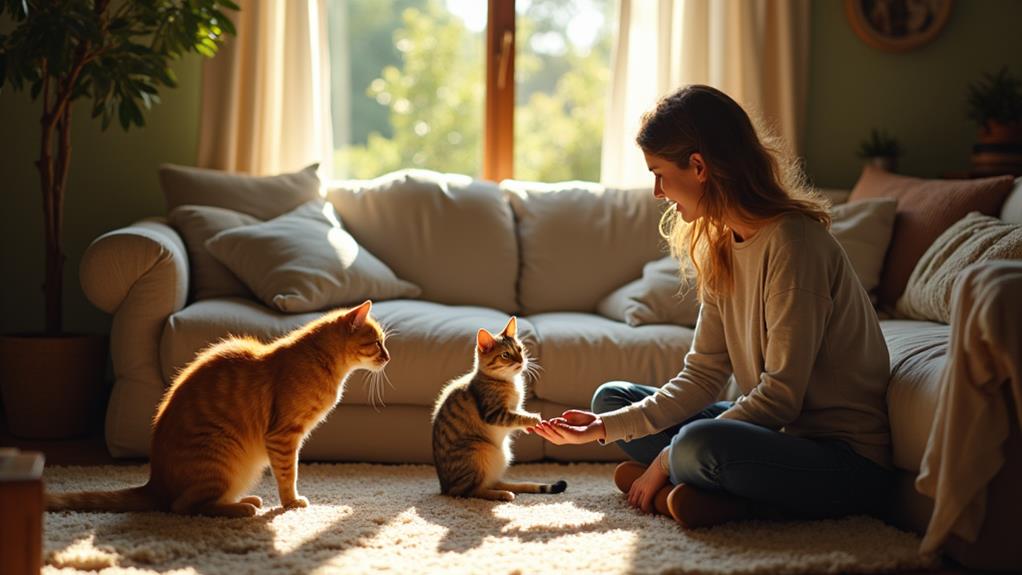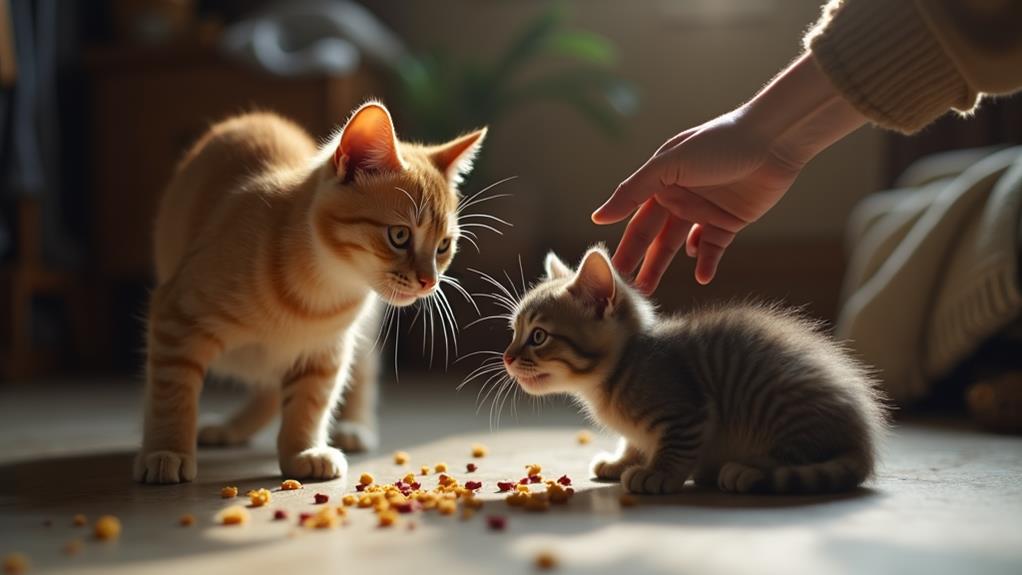How Long Does It Take for a Feral Cat to Become Domesticated?

Taming a feral cat to become a domesticated pet is a gradual process and can take weeks to months. It largely depends on the cat's maturity and temperament. Kittens are generally easier to tame than adult ferals. Begin by creating a secure and quiet environment. Use consistent feeding routines to build trust while allowing the cat to adjust at its own pace. Patience is key as you gradually introduce interaction through voice and movement during mealtimes. Slowly, the cat may seek your companionship. Uncover more about creating a welcoming space and ensuring your new friend feels secure at all times.
Understanding Feral Cat Behavior
Many feral cats, driven by strong survival instincts, typically avoid human interaction. These instincts shape their behavior, making them wary and difficult to approach. Unlike domesticated cats, feral cats prioritize survival over socialization with people, often forming colonies where they rely on shared resources. Their natural instincts make them fearful of humans, and they tend to exhibit a range of temperaments, some more open to human contact than others.
The taming process for feral cats varies greatly. Feral kittens, if rescued young, preferably before 6 weeks, are more likely to adapt to human contact and socialization. Their behavior can shift as they grow accustomed to humans, making it vital to start the process early. Adult feral cats, however, present a greater challenge. Their wild behaviors and reluctance to trust humans often persist, making them more difficult to tame.
When approaching feral cats, understanding and respecting their space is fundamental. They may react with fight or flight responses when threatened. Patience and consistency are key to earning their trust, as the process of taming depends heavily on each cat's unique temperament and previous experiences.
Key Differences: Taming vs. Domestication
While taming and domestication might seem alike at initial glance, they are fundamentally different processes. Taming involves the behavioral modification of wild animals, aiming to reduce their fear of humans through consistent interactions. This can often be achieved relatively quickly, sometimes within weeks, as the animal becomes more socialized and accustomed to human presence. However, taming doesn't equate to domestication. Domestication requires genetic changes over a long-term process, involving controlled breeding to embed a predisposition toward humans in the animal's lineage.
Here are some key differences between taming and domestication:
- Taming: Behavioral modification through gentle, consistent interactions.
- Domestication: Long-term process requiring genetic changes via breeding.
- Fear of Humans: Taming reduces fear, but domestication aims for an inherent comfort with humans.
- Wild Animals: Can be tamed but not necessarily domesticated without generations of controlled breeding.
- Socialized: A tamed animal is socialized to humans, but not genetically predisposed like a domesticated one.
For example, Spanish fighting bulls are domesticated but not necessarily tame, showcasing aggressive tendencies despite their domestication status. Likewise, the Asian elephant demonstrates taming through training but lacks the genetic changes to be considered domesticated.
Assessing and Preparing the Environment

Understanding the distinction between taming and domestication sets the stage for effectively evaluating and preparing the environment for a feral cat. Start by selecting a small room where the cat can feel secure. Guarantee the environment is quiet and free from sudden noises. This will help reduce stress and make the cat feel less threatened. Place food and water bowls in an accessible area, along with a space for a litter box. These fundamental items create a sense of comfort and familiarity for the cat.
Monitor the cat's behavior closely. This will help you identify signs of stress or discomfort, allowing you to make necessary adjustments. Evaluate their maturity, as younger cats may adjust more quickly than older ones. You can also introduce familiar scents, like worn clothing, to create a comforting environment.
Establish a consistent feeding routine. This helps encourage trust and predictability, which are vital for the taming process. When moving or handling the cat, do so gently and securely by the nape if necessary, to avoid causing distress. By thoughtfully evaluating and preparing the environment, you set a solid foundation for building a positive relationship with your feral cat.
Techniques for Taming Feral Cats
Taming feral cats involves a delicate balance of patience and strategy. You'll find that building trust with these cautious creatures requires specific techniques and a lot of patience. Start by confining the cat in a secure space, like a cage or large carrier. This setup lets them acclimate to your presence without direct contact initially. Use enticing food, such as baby food, to encourage them to come closer. Gradually move the food nearer to you, allowing the cat to approach at their own pace.
Gradual exposure to your voice and soft movements during feeding times can help desensitize feral cats to human interactions. Your patience and consistency are essential here. Pay attention to their body language and let them initiate contact when they're ready.
Remember, each cat is unique, and some may socialize faster than others. Here are some key techniques for taming feral cats:
- Secure containment: Start with a safe, confined space.
- Enticing food: Use food to build trust and encourage closeness.
- Gradual exposure: Introduce your voice and movements slowly.
- Observe body language: Let the cat lead interactions.
- Consistency and patience: Foster trust over time.
With these techniques, you'll gradually see progress in socializing feral cats.
Safety and Health Precautions

Before introducing a feral cat into your home, prioritize its health and safety with a few fundamental steps. Initially, schedule a veterinary checkup to guarantee the cat is healthy and free from parasites. This visit is essential for vaccinations and to address any medical concerns. By doing so, you prevent the spread of diseases to other pets and humans in your household.
Next, create a quiet, secure environment for the cat to acclimate. Set up a designated space with necessities like food, water, and a litter box. This area should be free from fragile or harmful items to prevent accidents. Monitoring the cat's health regularly is critical. Keep track of vaccination schedules and maintain parasite control to confirm the cat remains healthy.
To help ease the adjustment, consider implementing calming remedies. Pheromone sprays or calming supplements can considerably reduce the cat's stress during this period. These measures not only create a safer space for the cat but also help it adapt to its new life at home. By taking these precautions, you contribute to a smoother domestication process, guaranteeing the cat's well-being and safety.
Building Trust and Socialization
Once you've guaranteed the feral cat's health and safety, it's time to focus on building trust and socialization. Start by establishing a consistent feeding routine. This basic step can take several weeks but is essential for encouraging the cat to approach without fear. Gradual exposure to your presence during feeding times helps the cat associate humans with positive experiences, making socialization smoother. Initially, allow the cat to observe you from a distance. As it becomes more comfortable, you can slowly reduce this distance.
Patience is your best ally. Socialization efforts can vary greatly based on the cat's temperament and past experiences. Some cats adapt within two weeks, while others may take several months. Engage the cat with interactive play and gentle vocalizations to further promote trust. Over time, this can encourage the cat to seek more human interaction.
Here are some tips to improve the trust-building process:
- Establish a consistent feeding routine to create a sense of security.
- Gradually expose the cat to your presence.
- Encourage positive experiences through gentle interactions.
- Use interactive play to engage the cat.
- Exercise patience—progress may be slow but rewarding.
Long-Term Care and Commitment

How do you guarantee a smooth changeover for a formerly feral cat into a domesticated life? It begins with long-term care, ensuring the cat's needs are consistently met. Establish a feeding routine that offers predictability, helping the cat feel secure. Socialization is essential—spend time daily interacting with your cat to build trust. Create a safe environment where the cat can investigate without fear, reducing stress during the adjustment.
Regular veterinary check-ups are non-negotiable. Vaccinations and spaying or neutering are vital for health maintenance. These visits also help identify any underlying health or behavioral issues that might arise. To prevent boredom and related problems, introduce enrichment activities. Toys, scratching posts, and interactive play provide mental stimulation, keeping your cat engaged and happy.
Commitment is fundamental. Understand that adjustment takes time and patience. Be prepared to adapt to the cat's unique behaviors and needs. Provide consistent love and care as the cat acclimates to its new domestic life. Remember, each step you take in caring for your formerly feral cat brings you closer to a harmonious relationship built on trust and mutual understanding.




